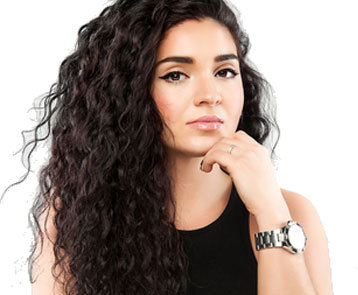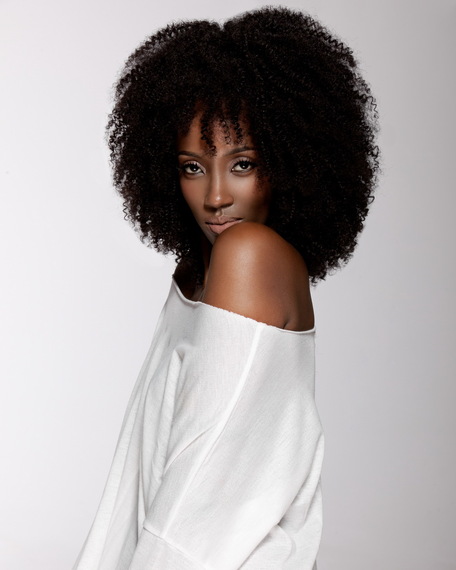Well let's face it, whether India Arie agrees or not, you are your hair.
Your hair is an extension of you, same as your dress sense, your spoken words and your disposition generally. And so, whether its winter, fall, spring or summer, a consistent daily hair care routine for your hair type is always a must.
Is your hair straight, wavy, curly, or coily? We have the right hair guide for you.
Straight hair, typically known as Type 1, falls smoothly and has a sleek feel since the natural oils from the scalp easily work their way to the bottom. Straight hair doesn't need much conditioning because it's typically soft and smooth. But that doesn't mean you can't suffer from common problems like flatness at the top, weak and stringy hair and your hair getting greasy more quickly.
Clean/care: Comb your hair with a small-tooth comb daily to distribute the sebum to the ends of the shafts. Wash your hair every other day. Deep condition your hair at least once a month to keep your hair soft and supple, while applying some other hair care tips necessary for your hair type.
Style: When your hair gets flat, try teasing your hair at the crown and adding in hair spray. Also consider blow drying your hair upside-down with a round brush.
Wavy Hair, typically known as type 2, has s-shaped curls down its length, it's the perfect blend between straight and curly. Sometimes the hair can appear straight with slight bends towards the ends of the hair, or it can have consistent waves throughout the shaft. This hair has ultimate flexibility, and is easy to straighten, keep wavy, curl and style. However, sometimes it can get greasy on the top and dry at the bottom, and is much more prone to frizz than other types.
Clean/care: Wash your hair two to three times a week, and use dry shampoo for in-between days.
Use a deep conditioner twice a month to keep your hair soft. You can also use a dime-sized amount of leave-in conditioner or a couple of drops of argan oil to keep your hair from frizzing during the day.
Style: Since wavy hair has many choices, you can choose whether you want to straighten it, leave it wavy or curl your hair more. We suggest keeping it natural and spritzing some texturizing or salt spray to give you a beachy look.
Curly Hair, typically known as type 3, is bouncy, playful, and full of volume. The strand thickness can range from fine to coarse but is most often fine. The greatest challenges for curly hair types are frizz, lack of shine, lack of curl definition, shrinkage and dryness.
Unlike straight hair, which tends to have a natural luster, curly hair has an uneven surface that does not reflect light very well. That means the curlier or wavier your hair is, the duller it appears.
Clean/care: Wash your hair just once or twice a week. Shampoo can strip the moisture out of curly hair more quickly, so make sure to apply some leave-in conditioner or argan oil.
Use a deep conditioning treatment once a week (before the day you wash your hair) to keep your hair silky and smooth, and your curls bouncy.
Style: Use a heat protection spray before you run your hair through a diffuser, and spend some time styling the individual curls. If your hair gets frizzy, take a spray bottle and spray your strands again to give the curl a chance to re-form.
Coily/Thick Hair, typically known as type 4 hair, has the tightest curls ranging from fine to coarse, with s-shaped and z-shaped curls. It is the most fragile of hair types. Many people with thick hair complain of having an itchy, flaky scalp. This is usually caused by insufficient rinsing after cleaning your hair: the shampoo soap leaves a residue which is sealed onto the scalp by the conditioner, causing dryness and irritation. This type of hair is filled with texture, so you won't have to worry about your hair slipping out of a braid or style. A common problem with coily hair is that it is dry and fragile, but that doesn't mean it can't look beautiful.
Clean/care: Wash your hair just once a week with a cleansing conditioner.
Seal your hair with heavy oils and coating butters (like shea-butter and coconut oil), right after the shower, and put it through a pre-treatment with a hot oil treatment to make it easy to wash.
Style: You can wear it natural, braid it, or put it up in a bun. You decide. If you want to give yourself a voluminous fro, use a diffuser to dry it 50% of the way, then let it naturally air dry. The less heat you use on coily hair, the better.
Is your hair Greasy?
A little oil or grease in your hair is normal; in fact you need it to keep your tresses in good condition. But too much can make your hair look dirty and limp. If both your hair and scalp are greasy, make sure you are not using a shampoo or conditioner that is too heavy for your hair.
Other tips for controlling greasy hair include:
•Cleaning your hair every other day. You may be tempted to wash your hair frequently, but the oil glands on your scalp are actually stimulated by massage so the more you wash your hair, the greasier your scalp becomes.
•Using the flat of your fingers to shampoo your hair for a more gentle cleaning action.
Or too dry Hair?
Too many coloring jobs or perms can weaken your hair structure and cause damage, as can excessive exposure to heat from hairdryers, curling irons, heated rollers and other electric styling tools. To restore your hair to its natural splendor, try following these techniques:
•Cut down on the use of hairdryers, curling irons, etc.
•Change your appliances regularly as the internal thermostats that regulate heat eventually break down.
•When hitting the beach or going for a swim, use a leave-in product to protect your hair.
These are generic tips, but are by no means all encompassing. Good advice usually comes from physicians trained specifically in hair care and hair therapy with special training in skin and hair cosmetic care.


